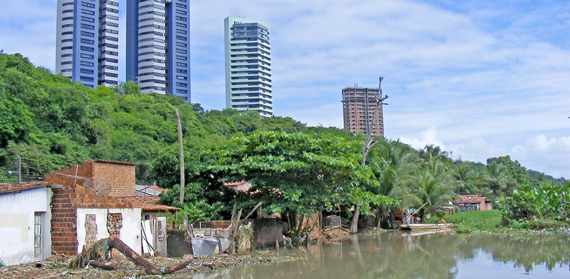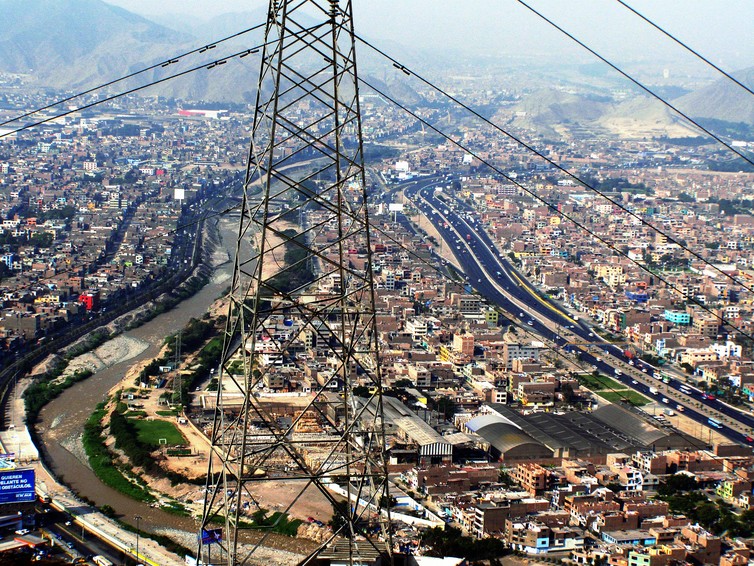Flotsam mixes with the marginal São José community, overlooked by new-build apartment blocks in Brazil. Fernando da Veiga Pessoa Flickr, CC BY
Guest Post by Neil Pyper
Latin America has traditionally been the world’s most unequal region, but it has recently shown signs of change. Through the 2000s, high international prices for exports have brought inequality levels down. Governments have made more concerted efforts to tackle poverty, mounting schemes such as conditional cash transfer, where recipients must meet certain criteria to access welfare benefits.
But despite all of this, levels of inequality remain high – and all the while, violence and insecurity have increased across much of the region.
This comes in part from the growth of drug-related organised crime, as well as the youth gangs that have proliferated in much of the region – but extreme inequality is a big part of the problem too.
The nature of violence and insecurity in Latin America reflects how unevenly the region has developed economically and socially since the boom years of the 2000s. Central American countries in particular have the worst problem with gang violence in Latin America, and some of the highest murder rates in the world. Part of the reason is because – with the exception of Costa Rica – these countries have especially weak ineffective governments, which have had less success at tackling inequality than various of their South American neighbours.
This means that levels of inequality in Central America are relatively higher than the rest of Latin America. Again, this has opened up a space for crime, and Mexican and South American drug cartels alike have strengthened their footholds in these especially precarious states.
Government initiatives to combat inequality and poverty, such as Venezuela’s Plan Bolivar 2000, have done little to make the region safer. Generally focusing on education, public health and vaccination programmes, they have principally targeted rural areas even though violence is increasingly an urban phenomenon.
To some extent that’s an understandable decision, since consumer demand as well as construction have created employment and bolstered development in poor urban areas. Yet levels of inequality within cities have remained high. Gang activities usually occur in poor areas of cities, and although what economic progress there has been been has benefited the region’s larger urban centres, anti-poverty programmes have done little for marginal urban areas.
All the while, increasing incomes in poor areas, and the subsequent opening of small businesses, have exacerbated levels of extortion. This leaves many areas of major cities such as Peru’s capital, Lima, to be tormented by organised crime.
From bad to worse
The most notorious criminal groups at work are the maras, youth gangs started by young Central Americans displaced to Los Angeles by the civil wars of the 1980s. When those wars ended, the gangs took their business back home to countries such as El Salvador, where they operate to this day. Along with these groups, many other types of urban gangs have also cropped up throughout the region.
San Juan de Lurigancho district in Lima, Peru. KaMpEr flikr, CC BY
In Central America, as well as in countries such as Venezuela and Brazil, urban gangs often take the place of law enforcement. In theory, they offer a degree of protection to local residents in return for extortion money or control over the sale of drugs in an area. This sort of alternative law enforcement is an effect of widespread police absence in poor urban areas. Indeed, when police do enter such areas they themselves are frequently involved in violence and corruption, meaning they are not welcome.
The state of the legal system only makes things worse. Residents of these areas are generally are not able to access lawyers. This means that they are not able to seek compensation through courts, which are, in any case, still often open to corruption. Such weak state authority leaves a power vacuum in poor areas, which in turn allows violence and lawlessness to thrive. This in turn creates a space in which gangs can operate.
That violence has increased even as economies have thrived shows how deeply entwined violence and inequality are. Addressing these would involve a widespread reform of key institutions such as the police and court systems, but the sheer scale of the challenge should not be underestimated.
If Central American economies remain stagnant, there is a risk that their still-high levels of inequality could start to rise again. That would drive down consumer spending and depress urban economies, offering urban gangs a perfect environment to recruit new members. As things stand today, the best we can hope for is that the security situation remains constant. At worst, with rates of inequality threatening to go up again, we can expect it to get worse in many areas.
Originally written for ‘the Conversation’.





Comments are disabled